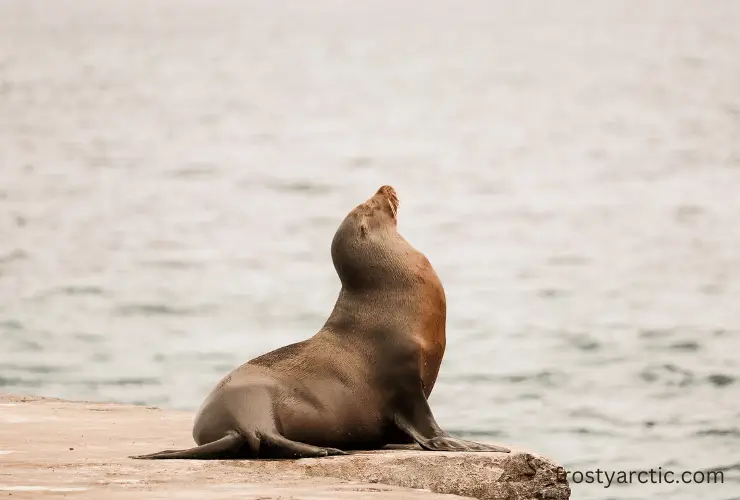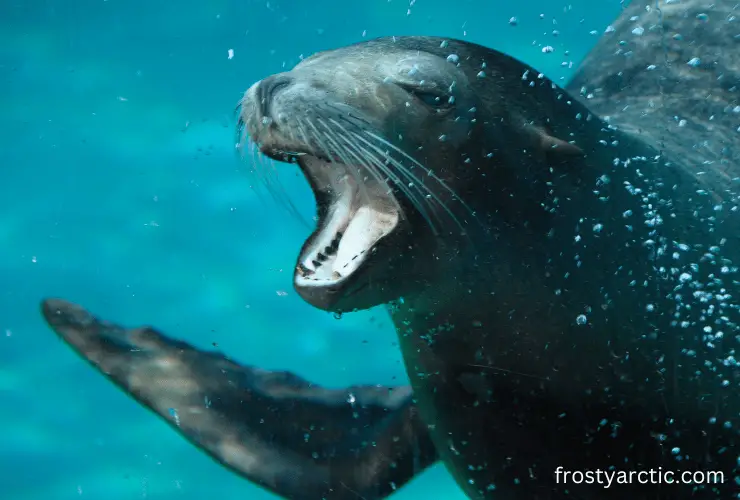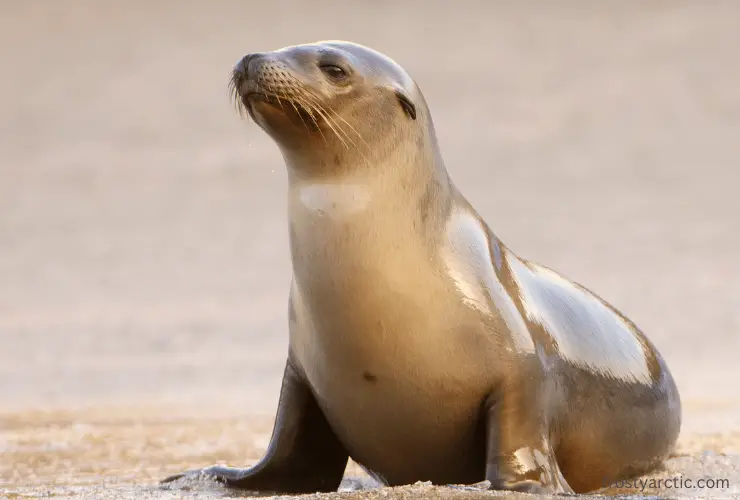Sea lions are carnivorous creatures. It means they subsist on a diet primarily composed of hake, squid, crabs, octopus, and clams. Being marine predators, they exclusively hunt for food in the sea. These creatures rely on their intelligence and exceptional swimming skills to track and capture their prey. This behavior is due to their coastal habitat.
Sea lions are highly skilled hunters. They exhibit great intelligence in their hunting techniques. Their ability to swim at impressive speeds allows them to chase down their prey with ease. It makes them formidable predators of the sea. With their sharp teeth and powerful jaws, sea lions can quickly and effectively tear through the flesh of their prey.
What do sea lions eat to sustain themselves in the ocean? How do they manage to hunt for their prey? If you’re curious to learn more about these marine predators and their fascinating diet, then read on! In this article, we will explore the dietary habits and hunting techniques of sea lions in greater detail.
What Do Sea Lions Eat and Drink?

Sea lions are fascinating creatures that have adapted to thrive in their aquatic environment. As predators, they are experts in tracking and capturing their prey. Like many animals, sea lions need food and water to survive. Let’s see what food sea lions eat and drink.
The following are the types of food that are commonly consumed by sea lions:
- cephalopods like squid and octopus
- hake
- northern anchovy
- opaleye
- herring
- lamprey
- steelhead salmon
Do sea lions drink water? Sea lions have a unique dietary habit – they don’t drink water. Instead, they fulfill most of their moisture requirements through their food. However, during the breeding season, male sea lions fast and may drink seawater to survive.
This fasting period can last several weeks, allowing males to focus on defending their territory. Once the fasting period is over, males resume their regular eating habits. This intriguing trait highlights the adaptability of sea lions. Moreover, their ability to thrive in challenging environments is marvelous.
How Do Sea Lions Eat?
Sea lions use their vibrissae to sense fish and hold their breath for up to 20 minutes. They can dive to depths of 400-900 feet to hunt. Some sea lions eat large rocks for unknown reasons. Some scientists believe it may act as a ballast to regulate diving speed.
Sea lions have a unique way of eating. They tear their food into large chunks and swallow it whole, without chewing. This method of consumption is facilitated by their sharp teeth and powerful jaws.
This physical adaptability enables them to rip through flesh effortlessly. There is no doubt that this eating habit is fascinating. It also demonstrates the adaptability of these creatures to their aquatic environment.
How Much Do Sea Lions Eat?

Dolphins organization’s researchers have mentioned the following facts about how much sea lions eat in the following captivating word: (source)
“Sea lions have a unique way of eating. They can eat cooperatively and consume 5-8% of their body weight daily, which can amount to 15-35 pounds of food. With their 34 to 38 teeth, sea lions are capable of grasping and tearing their prey. However, their sharp teeth are not used for chewing, as the food is immediately swallowed whole.”
Adult sea lions can consume up to 8% of their body weight in food per day. It equates to around 40 pounds in some of the larger individuals. This impressive feeding habit is a testament to the efficiency and adaptability of these creatures.
PBS organization’s news article has mentioned one of the shocking facts about sea lions’ diet: (source)
“Northern sea lions, the largest species of sea lions, have a varied diet that includes seals. They can eat a substantial amount of food in one sitting. They can consume around 5 to 8% of their body weight, which can be anywhere from 15 to 35 pounds. This voracious appetite allows them to fuel their bodies for days at a time.”
Diet of the South American Sea Lion
The population of South American sea lions is in danger. They are harvested in large quantities for commercial purposes. A Research Gate publication has given the food preferences of South American sea lions. Food availability directly influences the population status of sea lions. Let’s discuss what they talk about its diet:
“South American sea lions primarily feed on fish, with Raneya brasiliensis being the most frequent and abundant fish prey. They also consume cephalopods, particularly the octopod Octopus Tehuelches. These prey species are not targeted by commercial fishing in the study area.
The overlap in resource use between sea lions and fisheries is likely limited. During summer, the biomass of prey species is not directly affected by fishing activities. It may provide a greater amount of food for sea lions and contribute to the population recovery in the region.” (Source)
Diets of Mature Male and Female Steller Sea Lions

According to the research of Andrew Trites and Donald Calkins, the diet of mature male and female Steller sea lions are different. Let’s discuss what they have found in their research about the dietary lifestyle of this kind of sea lion. (source)
“Female Steller sea lions primarily consume the following fairly evenly distributed diet:
- Gadids
- Salmon
- Small oily fish,
- Smaller amounts of rockfish
- Flatfish
- Cephalopods
- Other fish
The female diet differs significantly from that of males. Males consume fewer salmon and more pollock, flatfish, and rockfish than females, with a preference for larger pollock. These differences in diet could be attributed to sex-specific differences in foraging areas or hunting abilities. It is likely related to the size disparity between male and female Steller sea lions.”
What Do Sea Lions Eat in The Wild?
Sea lions are opportunistic predators, meaning they will eat whatever food is readily available. In the wild, sea lions mainly feed on fish, squid, octopus, and other marine invertebrates. Some common foods that sea lions eat in the wild include:
- Fish, such as herring, anchovy, salmon, and sardines
- Squid and other cephalopods
- Crustaceans, including krill and crabs
- Small sharks and rays
- Octopuses and other mollusks
The type of prey consumed by sea lions in the wild can vary depending on the region and the season.
What Do Sea Lions Eat in The Arctic?
Sea lions in the Arctic mainly feed on fish, squid, and crustaceans. Their diet consists of both benthic and pelagic fish, such as pollock, herring, cod, capelin, and sand lance. They also eat squid, krill, and other crustaceans. In the Arctic, sea lions have to compete with other predators, such as killer whales and polar bears, for food.
Hence, their diet can vary depending on the season and location. They may feed on fish and squid that are found in deeper waters during the winter months. On the other hand, they may feed on fish and other prey that are found in shallow coastal waters during the summer months.
What Do Sea Lions Eat in Monterey Bay?

Sea lions in Monterey Bay feed on a variety of prey species, including:
- Sardines
- Anchovies
- Herring
- Squid
- Rockfish
- Mackerel
- Salmon
The diet of sea lions in Monterey Bay varies seasonally. It may also depend on the abundance and availability of different prey species. For example, sea lions may feed primarily on anchovies and sardines during summer.
They may switch to consuming more squid and rockfish in the winter. The overall health and population of sea lions in Monterey Bay can be impacted by changes in prey availability, temperature, and ocean currents.
Do Sea Lions Eat Penguins?
Yes, sea lions eat penguins. While sea lions and penguins may coexist in certain regions, sea lions are not known to be a major predator of penguins. Penguins tend to inhabit areas where sea lions do not typically feed, such as in colder waters around Antarctica.
In addition, penguins are well adapted to life in the water and can swim quickly and maneuver well. This makes it difficult for sea lions to catch them. However, there have been rare instances of sea lions attacking and killing penguins. But, this behavior is not common and likely occurs in unique circumstances.
Penguins International organization had given shreds of evidence of when sea lions were feeding on penguins: (source)
Sea lions primarily rely on small marine creatures and fishes to survive.
However, there is evidence of sea lions preying on penguins. You will find the sea lions (south Amirical Zone) are aggressive and attacking to the following sea animals.
- Rockhopper penguins (in Argentina)
- Gentoo penguins
They kill these creatures in the Falkland Islands, Chile and Argentina.
This incident was recorded on both aquatic and land surfaces during their swimming and resting time. However, yellow-eyed penguins are known as the favorite prey of NZ sea lions.
What Do California Sea Lions Eat?

The California sea lion reigns as the most common sea lion species on the West Coast of North America. They are voracious predators and can consume more than 50 different types of fish. These creatures are apex hunters of sea life and possess formidable hunting skills.
Their preferred and most reliable food sources are as follows:
- Herring
- Opaleye
- Anchovy
- Hake
- Octopus and
- Squid
Sea lions are skilled at tracking and capturing their prey. They are formidable predators that dominate the marine food chain.
Sea lions consume larger fish in addition to their usual prey. They do this, particularly in coastal regions, due to their plurality. Let’s take an example of California sea lions residing on the seashore of Washington. They eat huge salmon fish as a significant food source.
They often station themselves at the mouth of Lake Washington. These sea beasts feast on sizable quantities of lamprey and different fishes. These creatures thrive in diverse environments due to their adaptability and ability to exploit various food sources.
NOAA Fisheries researchers have found the following food habits about this cute mammal: (source)
“California sea lions primarily forage in the offshore coastal regions. There, they feed on a diverse range of prey, including squid, anchovies, mackerel, rockfish, and sardines. They typically hunt in upwelling areas, where food sources are more abundant. They hunt scavenge fish from commercial fishing gear, sport fishing lines, and fish passage facilities located at dams and rivers.”
What Do Australian Sea Lions Eat?
According to CDN’s researchers, Australian sea lions eat the following foods:
“Australian Sea-lions primarily hunt for their food on the ocean floor. Adult females with unweaned pups consume about eight to ten kilograms of food per day while at sea. They have an opportunistic carnivorous diet, which includes consuming squid, octopus, scale fish, penguins, rays, small sharks, blue-throated wrasses, and some crustaceans.” (Source)
What Do New Zealand Sea Lions Eat?
New Zealand sea lions feed in the water column. According to American Tarantula & Animals organization, New Zealand sea lions eat the following preferred food items: (source)
- Patagonian toothfish
- Antarctic horse mackerel
- Octopus
- Seabirds
- Squid
- Crustaceans
However, their diet can vary depending on the season and location. Females may spend more time on land during the breeding period. These females feed on limited fish, such as yellow-eyed mullet. Studies have also shown that New Zealand sea lions occasionally feed on penguins and other seabirds too.
FAQs
Do sea lions get eaten?
Yes, sea lions can get eaten by other predators. Sea lions have relatively few predators in the wild. Killer whales and certain species of sharks are the most common.
Killer whales, in particular, view sea lions as a primary food source. They hunt them in coordinated groups called pods. The other notable predator is the great white shark, which is notorious for preying on sea lions.
What do baby sea lions eat?
Sea lion pups remain dependent on their mothers for about a year. They start by feeding on the mother’s milk and slowly transition to small fish as they mature. During this time, the pup completely relies on its mother for survival. However, it’s common for mothers to leave their pups alone for short periods while they forage for food.
What do sea lions eat in captivity?
In captivity, sea lions are typically fed a diet of fish such as herring, mackerel, and capelin. Their diet may also include squid and other seafood. The amount and type of food provided depend on the individual animal’s age, size, and health.
Veterinarians and animal care staff closely monitor their feeding to ensure they are receiving proper nutrition. Sea lions kept in captivity at the San Diego Zoo are provided with five kinds of fish as their diet. These include capelin, squid, pompano, mackerel, and herring.
Conclusion
Sea lions are fascinating and cute creatures that have diverse diets and unique hunting techniques. Mostly, they are fish and cephalopod lovers. Whether in the wild or captivity, sea lions continue to capture our imaginations. They inspire us with their grace and agility.



3 thoughts on “What Do Sea Lions Eat? [Complete Diet List]”